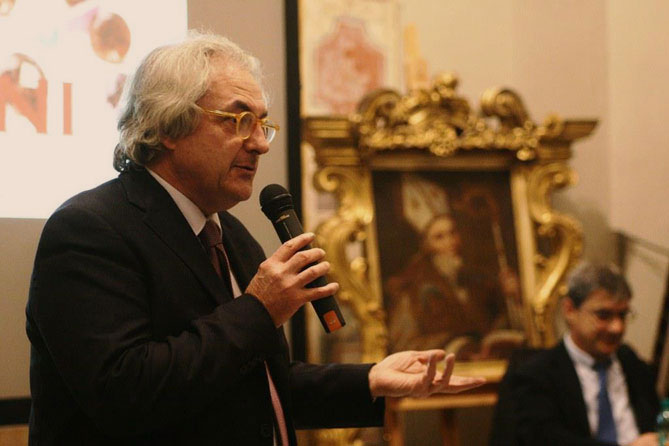The Noble College of Goldsmiths, a fine name for an ancient institution. It is caretaker of the goldsmith’s art, a responsibility handed down till today under the shadow of the Papal State. We interview Corrado di Giacomo, Camerlengo of the Noble College of Goldsmiths.
If you love jewelry and love Rome, then you must visit the Noble College of Goldsmiths in Sant’Eligio, the only church designed by the great Raphael. And if you do not find the bell to let you in, you do not have to worry, in fact the headquarters of the college is in the church. The Noble College was founded in the Papal States and was one of the Papal institutions, so it was natural that a church had its own institutional setting.
At Sant’Eligio we met Corrado Di Giacomo who is the Camerlengo, the historical name by which you greet the Chairman of College, who introduced us to the archives. We could see and feel the past and for a moment we entered the “workshops” of the great masters such as Benvenuto Cellini.
Corrado, what does it feel like to be a historical institution?
It is a burden and an honor, it means to preserve and grow a culture that always accompanies man. The Noble College of Goldsmiths was founded as a partnership between master craftsmen in order to preserve and protect over time the ancient and precious art and culture of jewellery and silver ware. To carry out this activity over the centuries there have been cultural activities such as lectures, courses, awards, addressed with particular attention to young people who will one day take our witness and be part of the new history.
Our archive is part of this culture and you can visit it by appointment with the conservation consul. To come into contact with the ancient manuscripts is a unique experience, especially for Americans who often show greatest respect for anything that goes back to before the western discovery of America in 1492, and they do not dare to touch the pages. Being at these scenes fills me with pride in the role that we actively perform to support the category of goldsmiths and gives a new meaning to our institution.
What are the roots of the institution, how far back in time?
The story of the Noble College of Goldsmiths is actually even older than the formal institution as we are the heir of the ancient guilds of art that had their roots in Roman times. In fact, the foundation of the corporations – or better still the Collegio – dates back to Numa Pompilius one of the first seven kings of Rome. One of the goldsmiths’ collegio, called firstly Aurarius Faber and later Aurifex, is among the oldest.
The University of Goldsmiths, Blacksmiths and Sadliers is the Sixth Guild and was originally based at the Church of San Salvatore alle Coppelle, erected in 1196 under the pontificate of Celestine II. A written policy of our business is already in the statutes of Rome in 1358, where it was stated that silver would have a ” punch ” to guarantee it and, therefore, the papal authority needed an organization to control the punches.
In 1404, the Sixth Guild was split into the three Arts and started autonomous confraternities, which continued to bond under the same patron Saint’Eligio di Nojon. Only at the end of the fifteenth century did the goldsmiths decide to form their own guild, independent of the others - what became the Noble College of Goldsmiths.
A few steps from the Tiber, and in a most beautiful part of Rome: the history of your headquarters deserves to be heard.
On 13 June 1508, the Guild of Goldsmiths bought land in the district Regola, near the Tiber (Tevere) River, and forwarded a request to the Pope to build a new church to be dedicated to Sant’Eligio as the seat of the Guild.
The authorization was granted for the construction on June 20, 1509 by Julius II with a Papal Bolla. The project to create the church was entrusted to Raphael who, despite the influence of Bramante his teacher, impressed his genius on the building and made it a little jewel to be handed down to posterity. Sebastiano da Como, bricklayer, was commissioned on 11 November 1516 to construct the new church. Today we are still in that church and our office has never changed during all these centuries.
How many Camerlenghi have there been and how does it feel to lead an institution with such deep roots in history?
Over the years, but I would say over the centuries, about 250 Camerlenghi have ruled. Personally, I hold this office with great pride, but at the same time with great responsibility. I try to work, always keeping firm the foundations of this ancient and noble association, with a watchful eye toward the future and with great attention for the new generations.
Past and future: How do you see the role of the “current” Noble College of Goldsmiths in the spread of the goldsmith art?
Of course, our association was created to protect this ancient art, but at the same time to continue to develop in life just so that the art is not lost. Today more than ever I am convinced that the craft has an active role in society and can be the driving force for a complete statement of Made in Italy in the world. In this we are the masters and we should not forget it!
I invite everyone to visit us and share with us the delights of a concert, a talk on the art of the goldsmith, and the different events that you can find on the site of the Noble College of Goldsmiths.






Follow us